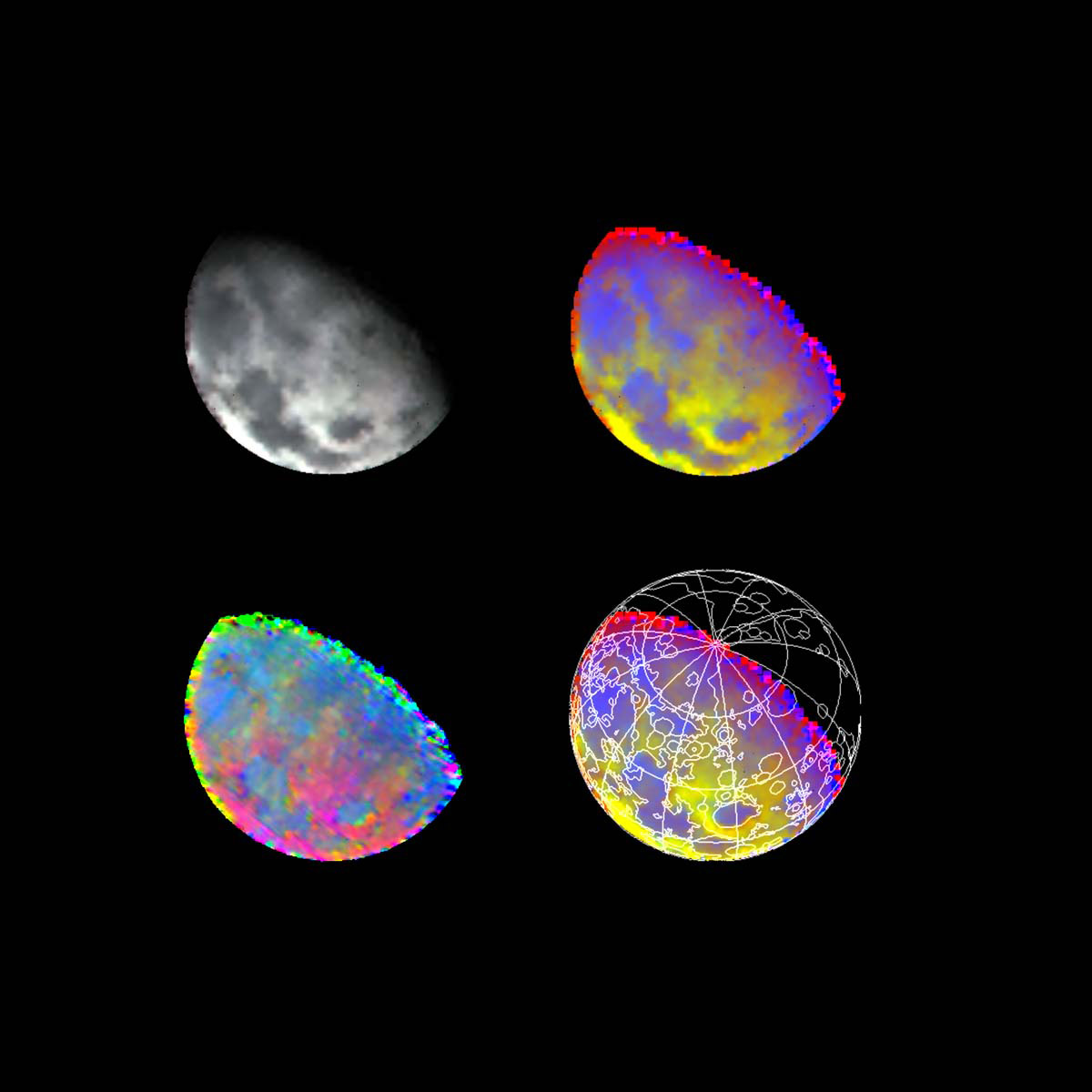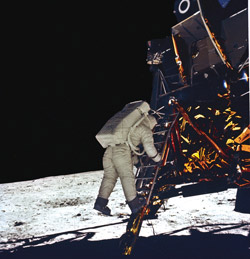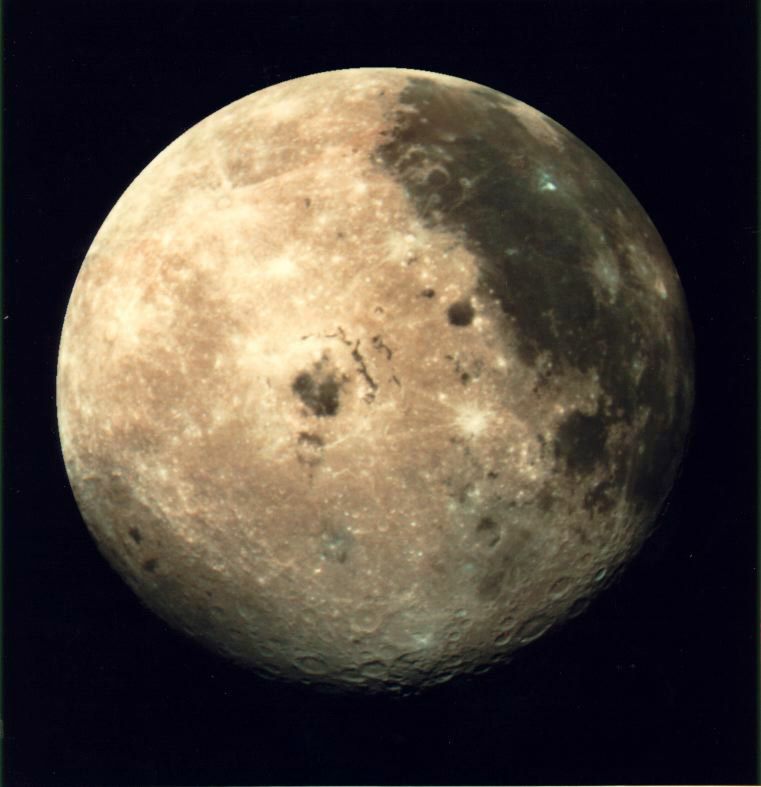Lesson: A Garden on the Moon
(Provided courtesy of the National Aeronautics and Space Administration, the International Technology Education Association, the Center to Advance the Teaching of Technology, and Science and Engineering by Design)
In this two-hour lesson, middle-school students use the engineering design process to design a plant growth chamber for use on the lunar surface. They will work individually and in teams.
Objectives
Students will learn to:
- Explain that design is a creative planning process that leads to useful products and systems.
- Identify criteria and constraints related to the design and development of a plant growth chamber on the lunar surface.
- Apply the engineering design process to solve a problem.
- Identify and describe the major steps in the engineering design process.
- Explain that brainstorming is a group problem-solving design process in which each person in the group presents his or her ideas in an open forum.
- Use criteria and constraints related to the design and development of a plant growth chamber to brainstorm possible design solutions.
- Analyze possible solutions to the design challenge.
- Select an approach to the design challenge.
Teaching Tools/Materials/Equipment
Chalkboard or overhead projector; computer with Internet access; LCD projector and speakers; sketching and drawing sheets (optional); teacher rubric included in lesson
Before beginning this lesson, teachers are encouraged to familiarize themselves with the Packing Up for the Moon Educator Guide, available as a free PDF, from which this lesson is drawn. Teachers may want to print pages 38-39 (Design Brief), 40-41 (Plant Growth Chamber Design Steps) and 48 (Modeling Ideas). Page 14 of the guide shows applicable standards and benchmarks.
A useful powerpoint presentation of the plant growth chamber is available here.
Explanation
 Plant growth will be an important part of space exploration in the future as NASA plans for long-duration missions to the moon. NASA scientists anticipate that astronauts may be able to grow plants on the moon, and the plants could be used to supplement meals. But the plants would require a special chamber that replicates the growing environment found on Earth.
Plant growth will be an important part of space exploration in the future as NASA plans for long-duration missions to the moon. NASA scientists anticipate that astronauts may be able to grow plants on the moon, and the plants could be used to supplement meals. But the plants would require a special chamber that replicates the growing environment found on Earth.
NASA engineers have developed a plan for a lunar outpost. The station will be established near the lunar South Pole and be inhabited by two astronauts on a three-month mission. The available space on the lunar lander is extremely limited; therefore, all items must be designed to take up minimal space. The mission requires that a plant growth chamber be used to supplement the diet of the astronauts during their stay.
Challenge: Design a plant growth chamber that will be used by astronauts to grow lettuce and tomatoes as dietary supplements on the moon.
Requirements:
1. The lunar plant growth chamber must be able to provide a growing area of 10 square feet and have a delivery volume of three cubic feet or less.
2. The lunar plant growth chamber may expand to any volume desired.
3. The lunar plant growth chamber must be a separate, independent structure from the lunar station.
4. Placement and access to the chamber must make it possible for astronauts to tend to and harvest crops without venturing out onto the lunar surface.
5. The lunar plant growth chamber must have systems that provide light, temperature control, water and nutrient delivery and power.
6. The lunar plant growth chamber may link to the lunar station to get power.
Understanding the Role of Plants in a Lunar Base
Through the process of photosynthesis, plants remove carbon dioxide, or CO2, from the air, while producing oxygen, or O2 and food, shown as a generic unit of carbohydrate below. This entire process is the reverse of respiration for humans, where food and O2 sustain metabolic needs. Plant systems can also be used to help purify wastewater. Water evaporates from the leaves and resultant humidity can be condensed as a source of clean water. This process is called transpiration.
In space, plants will serve two main functions: oxygen production and food supply. A plant�s ability to supply the oxygen needs for a person depends largely on the species of plant and the intensity and quality of light it receives. At very high light intensities, wheat could supply much of one human�s food and all their O2 needs from an area as small as 15 square meters. At moderate light intensities, a diverse mix of crops could supply a more complete diet for one person from about 50 square meters and meet all of their O2 needs.
Procedure:
The teacher discusses the Constellation Program (the new vehicles and systems that will likely be used to transport humans to the moon and beyond) with the students. The teacher shows the video �Return To the Moon and Beyond,� one of several videos and images that can be used to show the new systems. �Camping on the Moon� is a section that shows a proposed design for a moon outpost. (Location can be found in the References section p.29). The teacher explains that: Invention and innovation relate to the development of new products, processes and systems.
Brainstorming is a group problem-solving process in which each person in the group presents his or her ideas in an open forum. Ideas are to be recorded but not evaluated during this step. Drawings and lists are common ways to record design ideas. Modeling, testing, evaluating and modifying are used to transform ideas into practical solutions.
The teacher reviews the basic steps of the Engineering Design Process.
- Identify the problem.
- Identify criteria and constraints (requirements).
- Brainstorm possible solutions.
- Generate ideas�develop multiple solutions.
- Explore possibilities�create a pro/con chart for each idea.
- Select an approach�based on requirements and pro/con chart.
- Make a model or prototype.
- Test and evaluate the design.
- Refine the design.
The teacher distributes copies of the Design Brief. Student volunteers read the design brief aloud to the rest of the class.
The teacher asks students to draw and label three examples of a flat surface with an area of 10 square feet. The teacher may choose to draw one example on the board to help students get started. The teacher demonstrates methods for solutions that involve the following steps: rectangles; circles; triangles; combinations of these shapes.
Student activities:
1. Students, working individually, use the KWL Chart to enhance their understanding of the requirements for a plant growth chamber to be used on the lunar surface.
2. Students, working in groups of two to four, will use the engineering design process to develop a prototype of a lunar growth chamber.
3. Student groups will: a. Assign a project manager. b. Discuss the problem and take notes. c. Individually sketch ideas and list possible solutions. d. Select a few ideas and develop detailed drawings. e. Evaluate each idea by identifying pros and cons. f. Select an approach that meets the criteria and constraints. Students document their work using the resource, Lunar Plant Growth Chamber Design Steps.
If time permits, student groups may make an oral presentation to the class describing the use and function of the lunar plant growth chamber.
Evaluation
Student knowledge, skills and attitudes are assessed using selected response items and rubrics for class participation and brief constructed responses. The rubrics are presented in advance of the activities to familiarize students with the expectations and performance criteria. They are also reviewed during the activities to guide students in the completion of assignments. The teacher may wish to develop a collection of annotated exemplars of student work based on the rubrics. The exemplars serve as benchmarks for future assessments and may be used to familiarize students with the criteria for assessment.
Enrichment
Students may read about and see more images of the components of the Constellation Program. Students may be asked to identify old and current technology being applied to this new endeavor as well as the new systems being developed. Students may also be asked to identify mission components as expendable versus reusable.
Short NASA video clips are available here:
Filed under: Grades 6-8, Lesson Plans








